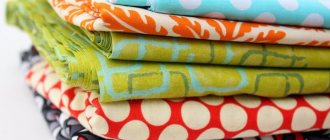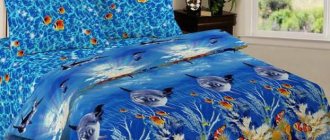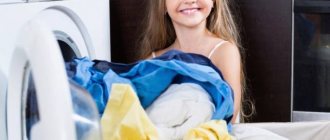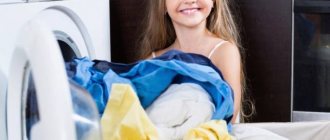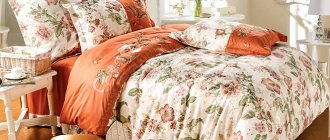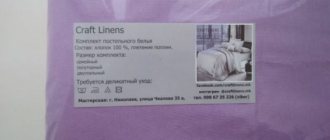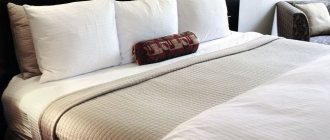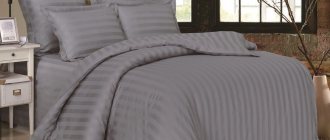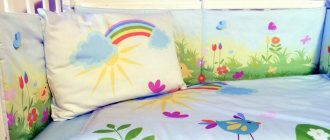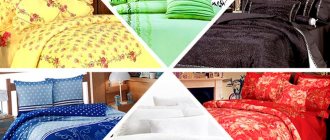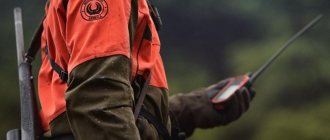Cotton
Thick cotton fabric can be made either 100% from natural raw materials or with the addition of artificial and synthetic fibers. The range of such materials is very wide; the most famous and popular are the following fabrics, obtained in various weaves:
- Twill.
It is produced with a diagonal weave, so on the front surface it has a pronounced diagonal pattern or a small herringbone rib. Twill fabric is characterized by wear resistance, strength and durability. It is used for sewing trousers, suits, workwear, curtains, and demi-season outerwear. - Moleskin.
Produced in a very dense satin weave with reinforced weft and warp threads. This is a smooth, hygroscopic, comfortable fabric, most often dyed dark. Moleskine is resistant to wear, friction and other deformations, is easy to clean and does not electrify. It is used for sewing workwear for hazardous industries, trousers and outerwear. - Velveteen.
Fabric with small or large longitudinal rib. Its name translates as “royal cloth”. This is a material with a luxurious appearance, soft, durable and almost wrinkle-resistant. Retains heat well, but requires maintenance and can shrink. Demi-season and children's clothing, trousers, and dresses are produced from ribbed fabric. Often used for sewing curtains, bags and hats. - Poplin.
A finely ribbed fabric formed by thickened weft threads. Can be painted in a wide variety of colors and patterns. Soft, durable, breathable and inexpensive material with a slight sheen. High hygroscopic properties make it possible to use poplin for the production of curtains, bed linen, casual clothing and home textiles. - Tale.
Soft fabric with pile on the reverse side. Retains heat well and hardly stretches. It is used to make children's and casual clothing. - Jeans.
Can be made using one of the twill weave types. This is a durable fabric that allows moisture to pass through and retains heat. There may be a small inclined or vertical scar on the surface. Used for sewing jeans, outerwear, shoes and bags. - Pique.
Its popular variety is called waffle fabric. The weave, which forms a pattern on the surface in the form of small honeycombs or diamonds, can be brushed on the reverse side. The fabric has an original appearance and excellent hygienic properties. This soft, practical fabric is used for sewing polo shirts, dresses and skirts, home textiles and children's clothing. - Jacquard.
Thick fabric based on linen or cotton raw materials. It has a dense structure with a relief surface. Wear-resistant, easy to care for, attractive in appearance and durable fabric.
Using a combination of cotton and artificial or synthetic fibers, fabrics with completely different characteristics can be obtained. The weaves used are the same as for pure cotton.
History of creation
Kevlar was first created in 1965 in America. It consists of synthetic fibers "armid". They are what give the material its strength. The raw material has a relatively low weight and at the same time excellent resistance to various types of influences.
Since the creation of the canvas, it has been in great demand in the market. Decades later, the Raw Material remains relevant and is considered the most durable in the world. It's amazing how fabric can be stronger than metal. However, this is possible and it has been proven repeatedly.
The secret lies precisely in the synthetic fiber Armid. It makes the fabric so durable and resistant to external influences. Kevlar has been used for protection since 1970. It was experimentally found that it can withstand a bullet with a caliber from 22 to 38 mm.
Silk
Several types of materials with increased density are produced from durable and delicate silk thread. Thick silk fabric has the same shine and smooth surface as more airy options. It is worth considering that these materials do not have very great heat-shielding properties .
Satin is the most popular dense silk fabric. Made with satin weave. Satin has an extremely smooth and shiny surface. The back of the fabric is matte, with a slight roughness. The atlas is characterized by the following properties:
- good hygroscopicity;
- hypoallergenic;
- does not accumulate static electricity;
- excellent drapability;
- elasticity and lightness;
- strength;
- durability.
In addition, dust particles and small specks do not settle on the satin. The material is not of interest to insects, which means it will not harbor ticks or other pests. Satin does not wrinkle, and things made from it keep their shape well.
In addition to its advantages, completely natural satin also has disadvantages. This dense silk fabric is easy to care for: it requires hand washing in cold water with special products. The satin should not be wrung out or twisted so as not to disturb the structure of the fibers.
Most often, satin is not made entirely from silk threads. Cotton, viscose, polyester, nylon, and acetate are added to the fabric composition. This expands the scope of application of the fabric. Silk satin is used for sewing dresses, elegant and casual clothes, curtains, bags, underwear and bed linen. Satin with the addition of synthetic raw materials is used for finishing furniture and decorating residential premises.
The following materials containing silk have a dense structure:
- Velvet.
Made with pile weave. This is usually a wool blend or silk fabric with piles of different lengths. Mainly used for sewing and decorating furniture, curtains, shoes, bags. The front surface can be smooth or finely ribbed (corduroy). The length of the pile can also vary. - Taffeta.
Produced by simple weaving. It has a very smooth surface with a glossy shine. This thin but dense fabric is used for sewing shirts and dresses. - Moire.
As a result of calendering, a material with a wave-like sheen is obtained. Durable, well-draped fabric is used for sewing festive clothes, curtains and decor. - Shanzhan.
It is distinguished by a wave-like color tint, which is obtained by using threads of different colors or shades for the warp and weft. Both silk and cotton fibers can be used. This smooth material with a peculiar shine is used for sewing evening and festive items. - Reps.
This dense fabric is made with a complex plain weave, which forms a fine rib on the surface. An easy-to-care material used for sewing summer and mid-season clothing, curtains and home decor.
Less popular are silk fabrics such as chesucha, brocade, faille, dama, duchess. They are used to make theatrical, historical and evening dresses. Semi-natural fabrics are used for sewing curtains, shoes, and bags.
Flaws
Despite all the advantages of the canvas, it is still susceptible to the influence of some factors that reduce its positive properties. Kevlar is afraid of water, ultraviolet rays, chemical and bleach cleaning. All this destroys the fibers and reduces the strength of the fabric.
With proper care, the canvas will retain its properties for many years. This material weighs more than ordinary fabric. It has a rough feel to the touch, but that's necessary to achieve longevity. The production of Kevlar is not particularly remarkable. The considerable cost is due to the beneficial properties of the canvas.
Progress does not stand still. Scientists create new technologies, devices and materials almost every day. However, Kevlar has been unique and irreplaceable for many decades.
Linen
The most common dense linen fabrics include:
- Crinoline.
Linen fabric with increased rigidity and density. Used as a cushioning material to give shape to clothing items. - Canvas.
Made from thick yarn, often treated with a water-repellent compound. Workwear, shoes, and bags are made from it. - Teak.
A striped fabric used for upholstery. - Matting.
Made with double or triple weave. Used for sewing everyday clothes.
In most cases, dense fabric made from linen yarn is used for sewing workwear and interior decoration.
What characteristics does velvet have?
The main advantages of velvet synthetic or natural fabric are:
- Softness. Touching velvet products gives a pleasant feeling. Clothing made from such material gives a special feeling of comfort;
- Density. The interweaving of five main threads gives increased density to the textile fabric. Thanks to this quality, sun rays and extraneous noise from the street do not penetrate into a room with windows covered with velvet curtains;
- Breathability. When sitting on surfaces covered with velvet and wearing clothes made from it, the body receives enough air to feel comfortable.
Another reason why velvet is valued by designers is the ability of products made from this fabric to retain their shape under any operating conditions. The fabric does not deform and, with proper care, always retains its magnificent appearance.
You can buy velvet inexpensively - a truly royal fabric - on the website punjabtextiles.com.ua. A wide selection of colors allows you to choose the best option for sewing beautiful fashionable dresses, skirts, jackets and trousers. The catalog also contains textiles that can be used to create luxurious curtains or upholstery of upholstered furniture at an affordable price. ***
Wool
Most wool fabrics have increased strength.
Dense wool fabric is a leader in heat-protective properties among natural fabrics.
Most often in light industry the following types of materials are used:
- Gabardine.
Made from twisted merino yarn. There is an inclined scar on the front surface. Wear-resistant fabric with a matte surface and good heat-shielding properties. This easy-to-care material has excellent drapability and hygienic properties. It is used for sewing outerwear and casual clothing, curtains, decor and workwear. - Tartan.
Woolen or wool blend fabric in a checkered pattern, also called “tartan”. Dense and warm material that is used for sewing outerwear, casual and national clothing, blankets and bedspreads. - Tweed.
Soft material made with a diagonal weave. There is a small pile on the surface. Elastic, almost wrinkle-resistant fabric with high heat and water protection properties. Outerwear, suits, skirts, and trousers are made from it. - Flannel.
Blended wool, wool or brushed cotton fabric with an inconspicuous scar on the surface. Due to its softness, it is used for the manufacture of children's and home clothing, bed linen. - Covercott.
Produced with twill weave from twisted threads. Elastic and warm fabric is used for sewing outerwear, suits and other everyday items.
In addition, the following materials are common:
- loden;
- tapestry;
- boucle;
- drape;
- cloth;
- Cheviot etc.
Density of fabric for bed linen
GOST 31307-2005 sets the minimum value at 110 g. per sq. m for pillowcases, sheets and duvet covers. This is the lower limit - in higher quality kits the weight may be higher.
We have already found out that the density of fabric for bedding sets is the most important parameter when choosing. But in this case, the rule that the larger the grammage of textiles, the better, does not always work. Although the material will be durable, it will be less breathable and may seem too rough to the touch.
There are a number of other parameters that can significantly influence the choice of fabric. For example, does it tend to become electrified over time or does it contain artificial fibers?
Which material is better for bedding and why? What fabrics are the thickest? Let's look at each type of textile in more detail to find out all their pros and cons.
Cotton
This is what natural plant raw materials look like, which will become the basis for clothing, bed linen and other products.
It is generally accepted that the best textiles are made from it. It is no coincidence that this natural material has gained such popularity among the people. It is durable and hypoallergenic and is used to make durable clothing, mattress covers and bedding.
Cotton is not a type of fabric, but a raw material in its production. If it is written that the set is made of cotton, it is important to clarify the weaving method and the content of natural fibers in the composition.
Pros:
- High-quality cotton textiles are easy to care for - can be ironed and washed at high temperatures.
- It does not cause allergies, so it is often used in cribs.
- Impressive service life. High-quality kits will last at least 5 years.
Minuses:
- Cotton takes a long time to dry.
- It may shrink after washing.
- Outwardly, it is difficult to distinguish cotton from synthetics; you need to look at the label to buy a product with a completely natural composition.
The density of cotton for sewing bed linen depends on the weave. For bed linen, chintz, various types of calico, poplin, percale, satin and jacquard are more often used.
Linen
Quality linen sheets look impeccable.
Linen fabrics are made from natural plant materials. The material has a smooth matte surface. This is a good alternative to cotton if you only want to sleep on natural fabrics. The flax gram is 125-150 g. per sq. m. This is an excellent indicator, which provides it with increased durability. It is recommended to wash dyed linen at a temperature of 40-60 degrees, turning it inside out. This is enough to clean it properly.
Advantages:
- natural origin;
- hypoallergenic qualities;
- natural flax kills bacteria and other pathogens;
- endurance and durability;
- allows air to pass through unhindered, so it won’t be hot under the flax in summer or cold in winter.
Flaws:
- wrinkles easily, requires ironing;
- high price;
Bamboo
It takes a lot of effort to turn tough bamboo fibers into a soft material!
Textiles based on natural bamboo are made by two methods: chemical and mechanical. The first option is cheaper to produce. The bamboo is decomposed using chemicals, after which they are thoroughly washed and the finished fibers are obtained. The second method is more environmentally friendly. There are also chemicals added to bamboo, but these are less aggressive protein enzymes. Fibers are combed out from the resulting mass, which are then treated with steam. You can find out about the production method from the information on the label. The chemical method is called “bamboo viscose”, and the mechanical method is called “bamboo linen”.
The density of bamboo is 120 grams per square meter. m.
Advantages:
- beautiful shine, due to which the surface resembles silk;
- does not cause allergies;
- not electrified;
- pleasant softness;
- excellent hygroscopicity.
Flaws:
- high price;
- wash only on low temperatures.
Bamboo-based canvases also require careful care. It is recommended to wash it at a temperature no higher than 30, spin only at low speeds.
Tencel
Some manufacturers use lyocell to sew covers for pillows and blankets.
Another name for tencel is lyocell. Unlike those listed above, this organic fabric is not made from cotton and linen, but from eucalyptus fibers. This is a soft silky material that has hypoallergenic properties. It is thinner than satin, which is why a lyocell bed is so soft and light.
Good Tencel bedding has a density of about 135 g per square meter.
Advantages:
- hygroscopicity;
- strength;
- bactericidal properties;
- does not become covered with pellets;
- has a pleasant silky shine;
Flaws:
- It shrinks, so manufacturers add extra centimeters to the product.
- Can be washed at temperatures up to 30 degrees.
Tencel is quite capricious and needs care. Do not store laundry in a damp place, ventilate it regularly, try to use gentle detergents and do not wring out the fabric at high speeds.
Silk
Real silk immediately attracts attention!
Shiny soft silk is associated with luxury and comfort. Previously, it was a sign of high status, mainly people of high position could afford it, because in its production they use only natural raw materials that are difficult to produce. It is based on material from the cocoon of the silkworm.
This is a lightweight material, warm and incredibly beautiful. The aristocratic shine of silk fabric is its trademark. That is why many people choose silk products as bed textiles.
Unlike other fabrics, the density of silk is measured in different units - in millimeters. High-quality silk textiles should correspond to 16-21 mm. This is a universal scale by which you can judge the quality of silk.
Advantages:
- impeccable appearance;
- pleasant tactile sensations from contact of linen with skin;
- bactericidal properties by nature;
- excellent thermoregulation - warm under it in winter and not hot in the summer;
- does not cause allergies.
Flaws:
- poor resistance to sunlight;
- silk slips, those who sleep on the edge of the bed or often grumble in their sleep may even slip out of bed
- high price;
- not easy to care for.
Silk requires special care. It must be washed on delicate cycles; it is recommended to use special powders and iron only at low temperatures.
Below are all popular fabrics based on cotton and other natural materials.
Chintz
Calico textiles are often used for sewing bright, beautiful and durable clothes.
Chintz is an inexpensive cotton-based fabric made by simply interweaving threads. The density of chintz varies from 80 to 100 g. per sq. m. Despite this, soft and lightweight bed textiles are made from chintz. It has a delicate structure, so wash chintz at 40 degrees or lower. It retains its quality even after 70-80 washes.
Advantages:
- chintz is pleasant to the touch;
- safe for children - can be used in a crib;
- has excellent hygroscopicity - it absorbs moisture well and evaporates it;
- dries quickly.
Flaws:
- wrinkles, chintz must be ironed;
- loses color faster;
- less durable;
- shrinks.
- more rigid compared to cotton.
Calico
One of the most common types of home textiles.
Calico is another cotton fabric with plain weave threads. This is one of the most common types of fabric along with satin. Grammage varies from 90 to 140 g. per sq. m. Choose sets from 110 grams, because models with low performance, although they are noticeably cheaper, their durability leaves much to be desired. According to Russian GOST, calico can only be made from organic cotton.
Advantages:
- affordable price.
- hygroscopicity;
- ease;
- strength and durability.
Flaws:
- Budget sets are less durable. The strength and softness of calico depends on the surface density of the textile, so look at this indicator when purchasing.
Before washing, bedding made from calico should be turned inside out. Washing at high temperatures is allowed. But in order to preserve the design for a long time, you can wash the calico on a delicate cycle. It is not recommended to wash calico together with other types of textiles, as this may cause it to become rougher.
| Varieties | Density, grammage | Properties |
| Discharged, light calico | 100-110 | Lightweight material, often used in clothing production. |
| Standard | 125 | Suitable for bed linen, can be with or without a pattern. |
| Lux | 130-140 | A more durable and strong version of standard calico. |
| Ranfors | 120-125 | Ranfors is a trade name for an improved type of calico. It is less heavy than luxury, but softer and lighter. |
It is impossible to say unequivocally what is the best density of calico for bed linen. If you need a durable option, choose “luxury”, and if a pleasant feeling from contact with the skin is important to you, pay attention to ranfors.
Poplin
Surface of material close up.
Poplin means "papal" in Italian. The fact is that in ancient times it was the pontiffs who chose it as the basis of their attire. This textile is still actively used today. The density of poplin fabric is about 110-120 g per square meter. It is quite durable and pleasant to the touch. High performance qualities are explained by an advanced weaving method - thin threads seem to envelop thicker ones.
Advantages:
- The material practically does not wrinkle, so the set does not need to be ironed.
- Breathes well and retains heat - a great option for the winter season.
- Pleasant tactile sensations due to softness.
- Affordable price.
- Wear-resistant, it is not afraid of direct sunlight.
All the disadvantages relate to cheap, low-quality types of poplin: if low-quality poplin was chosen, the material will shrink after washing, and its surface, consisting of many small scars, will very quickly begin to fray.
What temperature should be used when washing poplin so as not to spoil the material? A temperature of 40 degrees is recommended.
A bedroom set made of poplin, the surface density of which is at the level permitted by GOST, will be an excellent choice for the bedroom.
Satin
High-quality bed linen is made from satin weave textiles.
Satin is a cotton fabric with a fairly dense weave of threads. The best choice for home. The grammage of regular satin is about 115-130 - this is more than enough for a high-quality fabric. Satin looks truly luxurious. Even the material consisting of 100% cotton has a light, pleasant shine, which makes it similar to silk.
Advantages:
- Does not wrinkle, a good option for those who do not like ironing.
- It has a pleasant aristocratic shine.
- Durability and resistance to repeated washing.
- A high-quality set will last about 6-7 years.
Flaws:
- Over time, it may lose color, especially if you do not observe the temperature conditions when washing.
- It retains heat; in summer it can be hot under it.
Satin weave material can be washed at high temperatures and spin at high speeds. It is better to turn it inside out before washing.
It has many varieties. Depending on the weight per square meter, it has different qualities. Refer to the table to find out which satin density is best for bed linen.
| View | Density in grams per sq.m. | Peculiarities |
| Ordinary | 85-130 | Standard satin. Durable, durable, pleasant to the touch. |
| Printed | 170 | UV resistant and withstands direct sunlight. |
| Printed | 85-170 | Premium satin due to the way the pattern is applied. Due to the special method of applying paint, complex designs can be created. |
| Mako-satin | 220 | Made from high quality Egyptian mako cotton. Smooth and durable, it will last one and a half times longer than usual. |
| Satin jacquard | 135-140 | Premium variety with a voluminous embroidered pattern. |
| Stripe | 120 | It has a characteristic striped pattern, which is applied with fabric. |
| Crepe | 230–240 | The appearance is most reminiscent of silk or satin. |
Batiste
Cotton cambric is very light and soft to the touch.
This is the lightest and most delicate fabric because it has a low density - about 100 grams per square meter. Batiste is made from cotton, linen, silk and artificial threads. The best material is obtained from natural raw materials. It is suitable for people with delicate skin who value tactile sensations during sleep. Previously, cambric was available only to the rich, but today it has become available to the general population.
Pros:
- soft and pleasant to the touch;
- sophisticated design;
- made from cotton and linen;
- does not shrink.
Minuses:
- Less durable.
- Batiste is slightly transparent, so the pattern of the duvet cover and pillows can appear through it.
Caring for cambric is simple - just wash it regularly in a gentle cycle without other items. Use products without aggressive chemicals.
Percale
Material for luxury duvet covers, sheets and pillowcases.
These premium textiles are made from cotton or (less commonly) natural linen. It is thin, but at the same time incredibly durable - high-quality percale can withstand about a thousand washes. All thanks to the special composition with which the threads are held together.
The weight of percale varies greatly - from 100 to 160 grams per square meter.
Pros:
- not electrified;
- extremely durable;
- does not become covered with pellets;
- allows air to pass through well.
Minus:
- Expensive.
Percale requires special care. During the first wash, you should not bleach it, soak it in water for a long time, or use a temperature above 40 degrees. In the future, it is recommended to use only mild detergents. It is better not to wash percale in hard water, which means the water will have to be softened.
Other materials
Dense fabrics may include artificial and synthetic fibers and threads. Increased density is achieved mainly due to reinforced weaves.
Knitwear can also be dense if it is made from thick yarn, knitted in a double or triple weave, or has a thick pile, brushed or complex pattern . Thick cotton knitwear is called interlock. The loops of the fabric intersect, which provides additional density and strength. This is a material smooth on both sides, with excellent thermal insulation and hygroscopic properties. This knitwear has almost no stretch and is resistant to wear and deformation. It is used for sewing children's, sports, home and casual clothing.
Footer is knitwear, also made from cotton. There is a slight comb on the back side, while the front surface is smooth and dense. This knitwear has high hygienic and performance characteristics. It is used for children's, home and sportswear.
Jersey is a knitwear product formerly made from wool or containing a large amount of it. Now it is made from a wide variety of threads and fibers. This knitwear does not wrinkle, it only stretches in width. Jersey is a soft and pleasant to the touch material. Knitwear is used depending on its composition. Woolen jersey is used for sewing outerwear and warm clothing. Cotton knitwear is the basis for making children's and home clothes, silk is used for underwear.
Application
Raw materials began to be used to create special clothing, equipment and protective equipment. Basically, fibers are introduced to increase the strength of the product.
Kevlar is not afraid of fire and temperature changes. That is why this material is often added to firefighter suits. Ropes for climbers, backpacks and other devices are made from it.
Fibers are used in the creation of helmets and other special protective equipment (body armor, knee pads, gloves). The canvas has also been used in mechanical engineering. It is used in tire reinforcement and added to composite materials.

